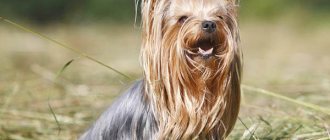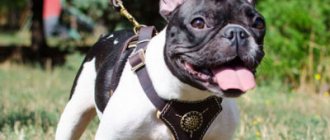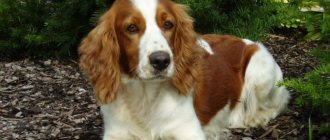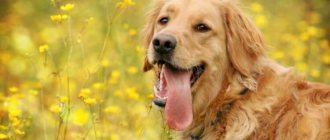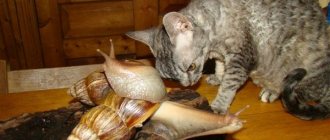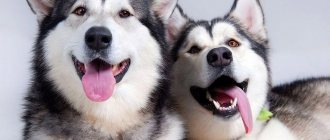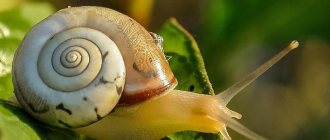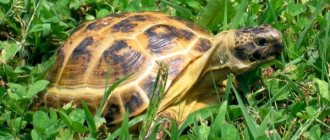Huskies are powerful, athletic dogs that are suitable for active people. When getting a puppy of this breed, you should be prepared for the fact that the baby will turn into a hurricane if he is not raised and given proper exercise. However, the undoubted advantage of keeping huskies is their unpretentiousness.
Caring for this dog includes brushing during shedding and proper nutrition.
Contents in the apartment
There is an opinion that huskies should not be owned in a city apartment:
- Northern sled dogs love space and cold. The apartment suffers from heat and cramped conditions.
- Aviary animals shed in spring and autumn for 3–4 weeks. In indoor dogs, biological rhythms are disrupted and hair falls out all year round.
- Huskies cannot be left alone. They chew things and furniture, tear off wallpaper and floors.
Meanwhile, many owners managed to cope with difficulties and accumulated positive experience of keeping a husky in a city apartment:
- According to the observations of the owners, dogs normally tolerate the heating season and summer heat. The double coat protects animals from overheating. The light fluffy undercoat together with the guard hairs form an air layer. It does not allow heat and cold to pass through, creating a comfortable temperature at the surface of the skin.
- In summer, at temperatures of 30℃ and above, both animals and people suffer. At home, it is useful to turn on the air conditioner and additionally lay out a cooling mat for your pet.
- Huskies do not shed more than other breeds with thick coats. If you brush it regularly with a furminator, the hair will not fly all over the house.
- The issue of cramped space is controversial. Huskies need a loving, attentive owner. If the owner disappears 12 hours a day at work, then it makes no difference to the dog where to sit locked up - in an enclosure or in an apartment.
- The behavior of a husky depends on the owner. Adequate owners hide shoes, clothes, remote controls, phones and other things away. From an early age, the puppy is accustomed to “chew” toys, rewarded for every contact with them.
- On walks, the dog is allowed to throw out its accumulated energy. They select such a level of physical activity that there is no strength or desire left to organize pogroms.
Ideal order and cleanliness in the house is difficult to maintain with any dog, even a small breed.
Walking and exercise
For sled dogs, the load should be all year round. If it is not possible to do exercises in a harness, then walking on a leash can successfully replace them. Naturally, the age of the dog is taken into account. There are several important principles:
- in summer, walks should be in the cool part of the day to prevent heat stroke;
- duration from 1 to 4 hours, but it is better to devote more time to walks;
- A special feature of caring for a Siberian Husky involves walking without a leash so that the dog can enjoy freedom. If this is not possible, then a long leash will come to the rescue;
- regular exercise.
How to walk with a husky
The puppy begins to be taken outside after the first two-stage vaccination, from about 3 months. They are accustomed to the collar and leash in advance, wearing it at home for 15 minutes a day. Until contact is established and the command “Come to me” is firmly mastered, they are not allowed off the leash.
For a puppy, being outside opens up a new world of sounds, smells, strangers and dogs.
Even huskies trained to call often get carried away and run away. The only way to eradicate a bad habit is to become interesting to your dog.
To release the energy of huskies, measured walking is not enough; they need physical and mental exercise:
- Intensive training: learning basic commands, tricks.
- Jogging behind the owner's bike.
- Skiing.
- Driving loads with sledges and sleds.
It is a common belief that you need to run 10 km a day with a Husky. This is true for sporting dogs that are being trained for competition. Domestic huskies are different, not everyone likes to cover kilometers and carry loads. Running is completely replaced by intensive training of active teams and active games.
Huskies love active walks.
Two walks a day for 15 - 30 minutes are clearly not enough for a husky. Usually they spend from 3 to 5 hours a day outside, but for a dog it is not the duration of walks that is more important, but the intensity of the load.
Read on the topic: The real story of the feat of Togo and Balto, the leaders of the teams who saved the city from the epidemic.
Breed varieties
Husky is a common name for sled dogs from different regions. Depending on the territory of origin, the following types of huskies are distinguished:
- Alaskan Husky. It is related to Sheepdogs, Malamutes and Border Collies. These are short-haired huskies that feel great even in the harshest weather. Very affectionate, sweet and devoted creatures. They get along well with small children.
- Klee-kai. American mini version, released in the States in the 70s. XX century An adult Klee Kai Husky grows up to 40 centimeters at the withers and weighs no more than 7 kilograms. An active, smart and cheerful dog. Despite its small size, it has good health and lives up to 16 years.
- Siberian Husky. One of the oldest indigenous breeds. Bred by the Chukchi as a sled dog. They grow up to 50-60 centimeters, very hardy. Not suitable for hunting.
- Sakhalin Husky. Powerful and hardy dog. Can reach up to 70 centimeters at the withers. A distinctive feature is the lush “collar” in the neck area. This is the longest-haired husky among all representatives of the breed. He loves people and has a calm disposition. However, it is least common as a pet.
This is interesting! The Sakhalin Husky is sometimes called the Sakhalin Laika.
Living in a private home
In a country house it is easier for the owner and more comfortable for the dog. Huskies are not afraid of the cold and live quietly outside all year round. Before the pet arrives, the area is fenced off with a well-buried fence no less than 1.85 m high. Huskies know how to climb over fences and are skilled at digging.
If a husky decides to run away, obstacles will not stop him.
A spacious enclosure made of stainless steel is built in a shaded area:
- A canopy is installed on top to protect from sunlight and precipitation.
- At least 2 walls are left open so that the home is well ventilated.
- A recreation area is arranged inside: a booth or bedding.
- Set out bowls for food and water.
Huskies are not chained to guard the house. They are too good-natured towards strangers and will never become vigilant watchmen.
Aviary dogs also need walks, intensive training or sports activities. If the pet is released onto the property, then bad habits are taken into account: huskies like to dig holes in beds and flower beds, and hunt poultry and small animals.
Leash training
A baby husky must be taught to use a leash from the age of 3 months; walking with a freedom-loving dog without a leash can result in the loss of the family pet. In addition, the domestic pet has very developed hunting instincts; the animal, when free-ranging, can attack small dogs, cats, poultry, and pigeons. Most often, huskies are trained only by obedience commands; in the absence of experience, it is recommended to entrust the education of the animal to professionals.
Leash training can be achieved by any owner with daily exercise, patience and affection. Classes will bring positive results, provided that the pet considers the owner to be the leader and completely trusts him. Leash training consists of several stages:
- We put on the equipment and watch the animal’s reaction; puppies of the aboriginal breed do not like a leash, some individuals are afraid or aggressively rush at it. At this moment, you need to calm the baby, pet him and try to walk the husky on a leash a little in short steps.
- If the animal refuses to walk, you need to pause without removing the leash and use small pull-ups to encourage the puppy to move. When the baby begins to move around in the harness, the owner should immediately praise and pet his pet.
- If the dog clearly does not want to wear equipment, you can resort to treats, but the owner’s actions should always be gentle, clear and persistent. The puppy must realize that resistance will not bring results, and in any case he will have to walk on a leash.
- Periodically, during the first lessons, it is necessary to remove the leash, calm the pet and give it time to run freely.
Over time, the animal will completely trust the owner and calmly endure the previously unpleasant procedure.
We hope that Khasenysh owners liked our article. The animal should always be calm and interesting with you; try to walk with it more often in new interesting places. Tell us about the antics of your graceful beauties.
Grooming
Husky wool repels water and dirt due to natural lubrication and a reduced number of scales on the surface of the hair.
Dogs are bathed with zoo shampoo no more than 2 times a year. Human detergents are drying and irritating to pets' skin. The rest of the time, wash off the dirt with cool water. From frequent bathing, the hair loses its ability to clean itself, and a dog smell appears.
During shedding, the fur is combed with a furminator every 3 days. The old undercoat is completely removed in 4 – 6 treatments. You will have to use a comb and a slicker brush every day until the end of shedding.
The rest of the time, the coat is combed once every 7-14 days with a furminator or 2-3 times a week with a fine-toothed comb.
Huskies cannot be cut. Dogs with short hair are deprived of a protective layer of air that protects them from cold and heat. Newly growing hair changes its structure. Wool loses its self-cleaning properties and never becomes the same.
Show huskies have points deducted for haircuts. Before shows, the hair on the cheekbones and between the toes is slightly shortened to make the dog look neater.
In hot weather, wool should not be wet. Wet, thick hair interferes with the evaporation of moisture from the skin, creates a greenhouse effect, and disrupts heat exchange. To cool, wipe the groin, stomach, armpits, and face with cool water.
Interesting Facts
- Some huskies can “talk.” They can make sounds that sound like individual words and phrases.
- Representatives of the breed exhibit heterochromia. Due to the different concentrations of brown pigment, a dog's eyes have different colors (one may be brown and the other blue).
- A team of eight huskies can cover a distance of up to 250 kilometers in 24 hours. Animals easily accelerate to 30 km/h.
- In 1 day, a Siberian husky burns up to 14,000 calories (professional athletes participating in a cycling marathon lose 2 times less energy).
- A dog's fur has the ability to self-clean. The animal does not smell like “dog.”
- There is a monument to a husky in the center of New York. The bronze statue is dedicated to the feat of the dogs who brought diphtheria serum to the American city of Nome. The delivery was carried out in difficult weather conditions. The diphtheria epidemic was stopped in 5 days.
Teeth
A husky puppy's teeth change from 3 to 6-7 months.
Usually, human help is not required; you only need to look into the mouth once every 2 weeks. Sometimes permanent teeth erupt, but milk teeth sit firmly in the gums and do not want to fall out. In this case, the puppy is taken to a veterinary clinic and the children's teeth are removed.
Dogs, like people, develop plaque on their teeth. Over time, it turns into tartar, which causes gum inflammation, mouth odor, and early tooth loss.
Some owners consider mechanical cleaning an optional procedure. Instead, give him pieces of carrot, apple, or dog sticks to chew on to clean his teeth. These methods do not completely remove plaque.
To prevent plaque buildup, teeth are brushed regularly.
The puppy is gradually accustomed to this unpleasant procedure from an early age:
- First, simply massage the gums.
- When the puppy gets used to it and stops resisting, wipe his teeth with a piece of gauze wrapped around his finger.
- Adult Husky teeth are brushed twice a week with a toothbrush and dog toothpaste.
Human toothpaste should not be swallowed or used on animals. Teeth brushing does not replace preventive examinations with a veterinarian dentist.
Home education
Husky is a very freedom-loving and quite wayward dog, which must be trained from puppyhood. If you miss this moment, you will get an uncontrollable dog that will sit on your neck. Socialization is the process of developing an adequate reaction in a dog to people. To do this, you need to play with the baby, pet him, and praise him so that the animal does not have fear of the person or the desire to attack him. Most Huskies have a very friendly nature; this breed is not intended for guard work. Siberian dogs are used mainly in sledding competitions, shows, or as pets.
A dog, especially a male, must see in its owner not only a friend, but also a leader, otherwise the animal will not respect and obey the person. To achieve the right relationship, you should not allow the animal to enter the kitchen, lie on sofas and armchairs, sleep in the same bed, and do mischief. Any dog, especially during adolescence and at the time of changing teeth, strives to gnaw on everything that comes to hand, to show character, to bite on the legs or arms. A good option during adolescence is a cage in which the animal is locked when the owners are away to save shoes and furniture. As you grow up and stop having dirty puppy habits. the cage can be removed
The most important thing is to punish your pet correctly so that the behavior is nipped in the bud, but the animal is not intimidated or harbors a grudge against the offender.
It is strictly forbidden to hit or shout at the husky, as this will make him your enemy!
The kids, like little children, are explained in a stern voice, slapped on the tail, older dogs are flicked on the nose, pressed to the ground by the withers for a few seconds, thrown onto their backs and severely scolded. The main thing is that the punishment follows immediately after the offense, and the owner always adheres to the same line of behavior.
It is necessary to love your animal, showing both severity and affection when raising it, then the husky pays its owner with selfless love and responsiveness.
Ears
Husky puppies' ears stand up very early, at about 6 - 8 weeks.
The main reason for the delay is an unbalanced diet. If they continue to hang by 3 months, the puppy needs vitamin and mineral supplements, especially calcium.
Veterinarians do not recommend deep cleaning of healthy ears: dripping peroxide, chlorhexidine, lotions into the ear canals, or crawling with cotton swabs. Antiseptics disrupt the microflora and increase the secretion of sulfur.
The inner surface of the ears is wiped with a damp gauze swab when dirt accumulates. Only the visible part is treated, the auditory canals are not touched.
Severe ear discharge, plugs, and itching are signs of otitis media or ear mites. Hygienic cleaning will not help here; the dog needs medicinal or acaricidal ear drops, which are prescribed by the veterinarian.
Possible diseases
Siberian Huskies have fairly good health and strong immunity; they are adapted to northern living conditions and persistent frosts. The health of a pet largely depends on the care and concern of the owner. As a preventive measure, you need to provide the necessary care to your dog:
- Maintain a balanced diet;
- Provide regular walks in the fresh air and physical activity;
- Surround with love and care.
It is especially important to monitor growth, development and health during puppyhood. However, like any other breed, the Siberian Husky is susceptible to diseases. Some diseases can be hereditary and transmitted from the mother, so it is advisable to pay attention to studying the puppy’s pedigree. The most common diseases:
Husky dogs have good health
- Different types of parasites. This species, such as Helminth worms, is transmitted from the mother. External types of parasites (fleas, ticks, lice) appear quite rarely in Siberian Huskies. If external parasites are present, using special flea shampoos or collars will help.
- A lack of zinc in a dog’s body can manifest itself in the appearance of bald spots, sometimes with bouts of vomiting or diarrhea in the dog.
- Diseases of the thyroid gland and joints are associated with heredity. Also, various eye diseases - this is a weak point of the Husky - can be inherited from the mother.
- Unfortunately, it is in the Husky breed that cervical spine injury is a common disease. This is due to the inexperience of the owner and is the result of improper distribution of the load on the dog’s cervical spine when harnessed to a sled.
- Myositis is also a common disease in Huskies. It occurs as a result of improper care of the dog during active running in the cold season. The dog definitely needs a pre-warm up and warm conditions after the run to cool down.
- Atopic dermatitis is a manifestation of an allergic reaction, mainly to food consumed.
The most beautiful Siberian Husky puppies
Paws
The claws are trimmed with a nail clipper when they grow to the floor and begin to clatter. The frequency of procedures is determined by yourself. City dogs have their claws partially worn down on the asphalt. If the dog only walks on the ground and grass, they grow back faster and are pruned more often.
Husky claws are cut at an angle, as in the first picture.
The fur between the toes is carefully trimmed. In summer, dirt accumulates between the pads; in winter, ice balls stick and interfere with running. Trimmed paws are easier to wash after walks.
In spring, summer and autumn you need to choose a remedy for ixodid ticks: drops, collar or tablets.
Appearance
Husky is not a very large breed. More often, such individuals are classified as medium-sized, with a symmetrical build.
The standard height of the animal is about half a meter, weight from 15 to 30 kilograms. The parameters depend on the gender of the dog. As a rule, males are larger and heavier.
Head
Dogs are distinguished by a sharply drawn head, wide at the top and tapering towards the eyes.
A rough or fine head will result in the animal being disqualified from the competition.
The lips stand out clearly on the muzzle, have characteristic pigmentation, and should not be loose.
Eyes
Huskies have brown or blue eyes that slant slightly toward the center. There are dogs with different shades of the iris. The eyes are almond-shaped.
Eyes that are too wide apart and too close together are a sign of disqualification.
Ears
Dogs' ears are pointed and triangular in shape. They are located high on the head, the tips are slightly pointed.
Jaws
The teeth have a scissor bite. Deviation from the standard is considered a disadvantage and in some cases will lead to disqualification from the competition.
Any other form of malocclusion is grounds for disqualification.
Torso
Huskies have a big heart. Their chest is powerful and strong, and their ribs are wider apart than other breeds. The chest should not be too wide. The shoulder blades should be at an angle of 45 degrees. Another slope is a reason for exclusion.
The back forms a straight line from the shoulder blades to the hip joints.
Neck
The neck is slightly arched, not too long. At the moment when the animal stands highly raised.
Tail
The tail is somewhat similar to a fox's: long, with a curved tip and fluffy fur. When the dog runs, it is slightly lowered, or takes the shape of a sickle. Twisted into a circle located above the back is a sign of disqualification
Paws
The animal has powerful and muscular legs of medium length. The pads are ideal for walking in the snow, but if the animal runs for a long time on a hard surface, it can get injured. To eliminate them, special shoes are purchased.
The front and hind limbs are moderately spaced, straighten straight when moving, do not bend or twist.
Wool
The wool is thick. There is a developed undercoat, medium length.
Color
Show dogs can be black to white in color with distinctive stripes. Extra stripes on the face and glasses are allowed.
Character
Huskies are extremely friendly dogs with a contradictory character. They need a strong leader nearby who can tame them. The stubbornness, willfulness and violent temperament of these animals can only be curbed by a strong-willed owner. For example, bringing the dog to fatigue with long walks or exhausting workouts.
Norms and feeding regime for a puppy and an adult husky
First, they decide on the type of feeding: buy industrial feed or cook it yourself. Different enzymes are responsible for digesting dry kibble and natural foods. With a mixed diet, digestion does not have time to rebuild, food is poorly absorbed, and fermentation begins in the intestines.
The daily amount of dry food is written on the packaging. With natural feeding, you will have to calculate it yourself. The volume of food is determined by body weight:
- For a puppy up to six months, 5 - 7% of weight.
- From 6 months and older 3 – 3.5% of the animal’s weight.
These are average norms; the specific amount of food depends on the animal’s mobility and physical activity. If the ribs cannot be felt, it means the pet is overfed; if they stick out too much, there is not enough food.
Up to 2 months, the puppy is fed 5-6 times a day; as he grows up, the portions increase and the number of feedings decreases:
| Age, months | Number of feedings |
| up to 2 | 5 – 6 |
| 2 – 3 | 4 – 5 |
| 3 – 6 | 4 |
| 6 – 8 | 3 |
| 9 and older | 2 |
Adult dogs are fed twice a day, preferably by the hour: in the morning no earlier than 8-00, in the evening no later than 22-00. The bowl of food is left for 20 minutes, then removed until the next feeding.
Diet
When preparing your diet, do not forget about the presence of proteins, fats and fiber in it. Carbohydrates are also an important part of a husky's diet, as they serve as a source of energy and are necessary for dogs, especially active breeds like huskies.
Important! Remember about vitamins and amino acids. Be sure to consult with your veterinarian to determine the appropriate nutritional supplements.
Adult animal
After 12 months, the dog can be switched to adult food . At this age, the husky no longer needs additional calories and vitamin supplements for growth. Mix puppy food with adult dog food, gradually increasing the proportion of adult food.
Puppy
Pay special attention to the puppy’s diet. If you decide to feed him natural products, then the following menu for a 2-4 month old husky will help you:
- Breakfast - 9:00 . Low-fat cottage cheese, grated carrots or 2 quail eggs.
- Lunch - 13:00 . 150-200 grams of meat or fish.
- Afternoon snack - 17:00 . 0.4-0.5 l of kefir.
- Dinner - 20:00 . Porridge with meat and vegetables.
At 3-4 months the afternoon snack is removed. At 6 months, lunch is removed, breakfast consists of cottage cheese, fish or meat.
Lactating bitch
The menu of a new mother must include:
- fish;
- meat;
- offal;
- cereals;
- dairy products and milk;
- vegetables.
There are also special foods for nursing dogs that contain increased amounts of essential substances:
- proteins;
- fats;
- vitamins
All you need to do is increase the frequency of feeding your dog in consultation with your veterinarian.
Attention! Don't forget about vitamin and mineral supplements.
Meat
The digestion of northern sled dogs is designed to absorb proteins and fats and practically does not break down carbohydrates. The basis of feeding a husky is meat. Three times a week it is replaced with offal and sea fish.
The share of meat in a husky’s diet is no less than 65–75% or 20–30 g per kilogram of the animal’s weight.
The table lists what kind of meat a Husky can eat:
| Meat | By-products | Fish |
| beef veal chicken turkey horse meat rabbit game pork without fat | scar liver lung kidneys tongue heart kaltyk trachea | cod hake pollock mackerel salmon tuna sea bass halibut |
A dog's digestive system is designed to process chunks of food. Therefore, the meat is not ground or turned into minced meat. The meat is given raw. After heat treatment, beneficial substances are destroyed. To destroy harmful bacteria, pre-freeze for 5 - 7 days.
The share of cereals in a husky’s diet does not exceed 5–10%.
Huskies do not digest porridge and pasta. The rest of the diet is distributed among vegetables, fruits, and dairy products.
To gain weight, buckwheat, rice, and rolled oats are sometimes added. If you overfeed a dog with cereals, problems with the skin and fur begin, the eyes become watery, and the overall tone decreases.
Menu
The diet of a husky at home and during physical activity is almost no different. But owners should take into account the nuances in the animal’s nutrition so that the husky has:
- shiny healthy coat;
- strong bones;
- excellent immunity.
Remember that it is strictly forbidden to feed your Husky table scraps . To ensure your dog receives as many nutrients as possible, add boiled zucchini, pumpkin, white cabbage and cauliflower to its diet.
At home
Let's go husky:
- special purchased food;
- meat;
- apples;
- bananas;
- dairy products.
You can also stick to a ready-made menu when choosing food for your husky every day.
First day:
- Chicken meat topped with yogurt - 400 grams.
- Buckwheat porridge - 150 grams.
- Vegetable oil - 1 teaspoon.
- Boiled carrots and beets - 150 grams.
Second day:
- Veal internal organs - 450 grams.
- Kefir - 200 grams.
- Green vegetables - 130 grams.
The third day:
- Pink salmon - 500 grams.
- Rice porridge - 150 grams.
- Bioyogurt - 200 grams.
Fourth day:
- Rabbit meat or beef - 450 grams.
- Yogurt - 150 grams.
- Boiled carrots, celery - 130 grams.
- A raw egg.
Fifth day:
- Chicken internal organs, offal, trimmings - 450 grams.
- Oatmeal porridge - 150 grams.
- Cottage cheese - 150 grams.
- Vegetable oil - 1 teaspoon.
Sixth day:
- Veal - 450 grams.
- Yogurt - 200 grams.
- Boiled pumpkin - 130 grams.
- A raw egg.
Seventh day:
- Buckwheat porridge with meat - 250 grams.
- Cottage cheese - 200 grams.
- Bioyogurt - 150 grams.
- Apple.
With workload by day
As the load increases, the amount of food should also be increased.
Feed your Husky:
- meat;
- fish;
- fermented milk products;
- porridge;
- vegetables and fruits.
Take a look at the sample Husky menu under workload.
First
Morning:
- Chicken meat - 300 grams.
- Bioyogurt - 200 grams.
- Boiled carrots - 2 pcs.
Evening:
- Chicken internal organs, offal, trimmings - 150 grams.
- Buckwheat porridge - 150 grams.
- Kefir - 130 grams.
Second
Morning:
- Sea fish - 250 grams.
- Rice porridge - 150 grams.
- The egg is raw.
Evening:
- By-products - 250 grams.
- Bioyogurt - 150 grams.
- Boiled vegetables - 120 grams.
Third
Morning:
- Beef - 300 grams.
- Yogurt - 120 grams.
- Vegetable oil - 1 teaspoon.
- Boiled cabbage and beets - 120 grams.
Evening:
- Buckwheat porridge - 200 grams.
- Cottage cheese - 150 grams.
- Apple.
Fourth
Morning:
- Chicken giblets - 250 grams.
- Oatmeal porridge - 150 grams.
- Boiled carrots - 120 grams.
- Vegetable oil - 1 teaspoon.
Evening:
- Rabbit meat - 250 grams.
- Bioyogurt - 200 grams.
- Boiled pumpkin - 120 grams.
- The egg is raw.
Fifth
Morning:
- Chicken meat - 300 grams.
- Bioyogurt - 150 grams.
- Boiled beets and celery - 130 grams.
- Vegetable oil 1 teaspoon.
Evening:
- Oatmeal porridge - 200 grams.
- Cottage cheese - 150 grams.
- Bioyogurt - 130 grams.
- Apple.
Sixth
Morning:
- Sea fish - 250 grams.
- Rice porridge - 150 grams.
- The egg is raw.
Evening:
- Beef offal and trimmings - 200 grams.
- Bioyogurt - 150 grams.
- Boiled carrots.
Seventh
Morning:
- Veal - 300 grams.
- Buckwheat porridge - 150 grams.
- Bioyogurt - 150 grams.
- Vegetable oil - 1 teaspoon.
Evening:
- By-products - 200 grams.
- Boiled vegetables - 130 grams.
- The egg is raw.
- Bioyogurt - 130 grams.
This breed is perfect for active people. Huskies love exercise and are designed for long distance runs and play. Knowing all the nuances of creating a diet for a husky, you can ensure your dog a healthy and long life.
Plant food
Vegetables, fruits and berries are needed as a source of fiber, vitamins, microelements, to cleanse the intestines and form stool. The table contains a list of vegetables that can be given to huskies without fear:
| Vegetables | Fruits and berries |
| carrots zucchini pumpkin cauliflower white cabbage broccoli bell pepper green beans turnip cucumber eggplant sometimes | apple pear banana blueberries strawberry watermelon pulp gooseberries raspberries currants melon |
Vegetables are added to the meat raw, chopped on a grater. Fruits and berries are offered as treats if the dog likes them.
Photo gallery
Below you can see a photo of a husky; in our opinion, this is a very cute breed of dog.
Dairy products
Fermented milk products are given as a separate feeding instead of meat. They improve the composition of the gastrointestinal microflora and enrich the diet with calcium.
Huskies can be given fermented milk products without sugar except sour cream:
- cottage cheese up to 5% fat;
- kefir;
- curdled milk;
- fermented baked milk;
- yogurt without additives.
To enrich the food with vitamins and microelements, it is useful to add to the main dishes:
- raw chicken, quail egg – 3 times a week;
- sunflower, flaxseed oil – 1 teaspoon per serving of food;
- bran;
- greenery.
Always leave a bowl of clean water freely available. The dog will decide for himself how much and when to drink.
Price
Siberian Husky puppies are quite in demand. Because there is demand, the price for this breed can be high. The cost, first of all, depends on the puppy’s pedigree. Without a pedigree, you can buy a dog for up to 10,000 rubles.
A puppy with a pedigree and meeting the standards will cost about 25,000-45,000 rubles, although the price of a Siberian husky can be much higher. There are many nurseries where you can buy puppies.
Using a Husky in a dog sled will give them great pleasure. However, this is possible only in the winter season and in climatic conditions with a large amount of snow. Well-trained Siberian Huskies will become your true friends.

